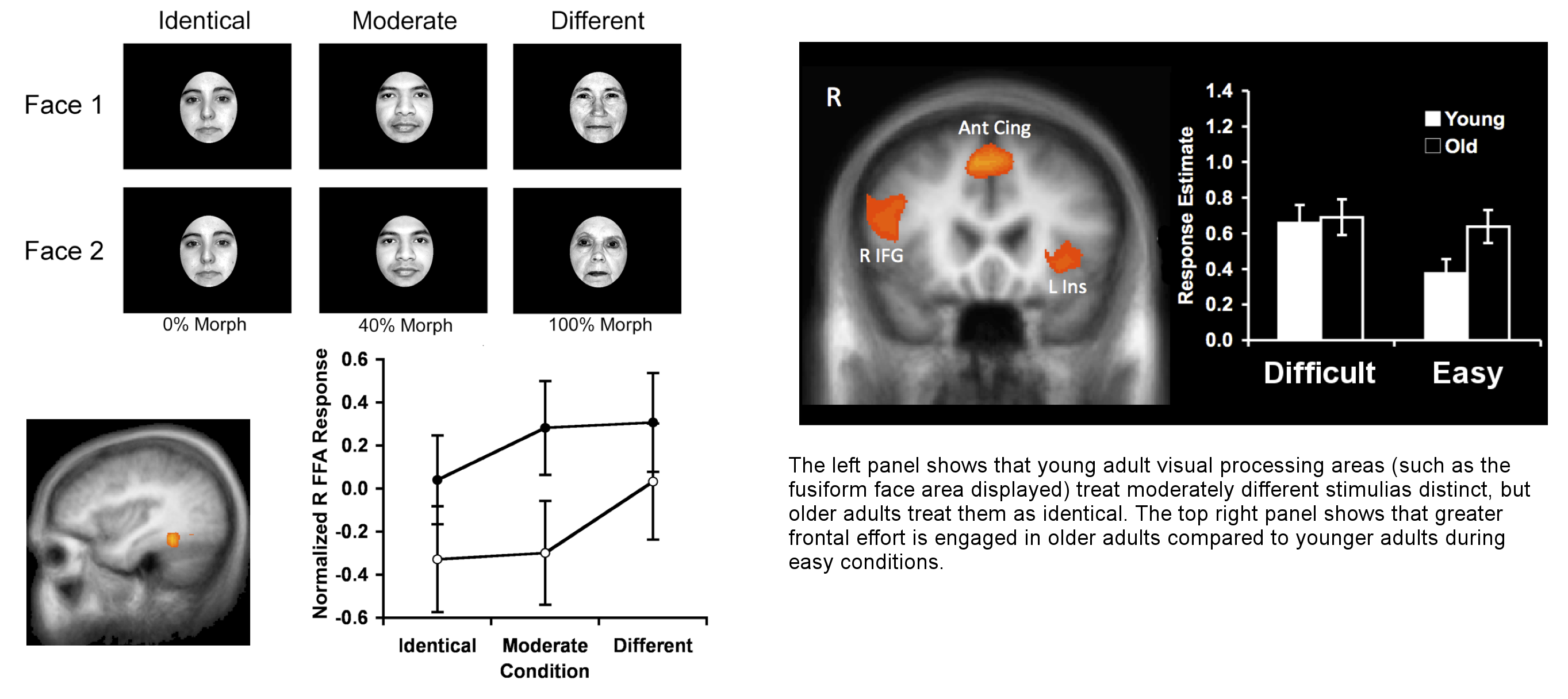Overview of our Research on the Cognitive Neuroscience of Aging
Everyone ages. Aging is the greatest risk factor for Alzheimer’s Disease, a debilitating condition associated with neurodegeneration and severe declines in cognitive processes such as memory and executive function, that affects 1 out of 8 persons (based on U.S. samples). Even older adults who are free from cognitive impairment still experience and show signs of cognitive decline that can have consequences on the daily functioning and freedom of the person as well as their caregivers. There is thus an urgent, important need to understand the nature of neurocognitive changes associated with aging in effort to prevent, ameliorate, or even reverse the detrimental effects of the aging brain and enhance the beneficial changes.
Some of our key findings show that the older adult brain have reduced neural selectivity of responses and so are less sensitive to subtle differences in external stimuli (see figure below adapted from Goh et al. (2010), NeuroImage, 51(1), 336-344). Another age-related pattern of neural engagement is that older adult frontal cortices tend to show higher levels of activity even when processing easy tasks, perhaps reflecting a greater effort required with age to perform even simple computations.

Critical recent work in this field has revealed that not everyone’s shows neurocognitive decline with aging, and not everyone declines in the same way either. These are hints that there are certain factors that mitigate the effects of biological aging on the brain and mind. In the figure below, the left panel shows that there are different patterns of longitudinal performance across individuals (and between cognitively normal (CN) and impaired (CI) groups) and across different cognitive abilities as they age (adapted from Goh et al. (2012), Psychol. Aging, 27(3), 707-719). The right panel shows that individuals with preserved cognition have less heightened longitudinal frontal brain responses (adapted from Goh et al. (2013), NeuroImage, 69, 43-50).

In the light of these findings from our own studies and also studies by other groups who find similar effects of aging, one of the primary goals in our lab is to discover and understand the factors that are important for healthy cognitive aging. In particular, our focus is on identifying patterns of cognitive engagement that further maximize the benefits of other well-known positive influences on the aging brain such as a healthy diet and active lifestyle.
Associated Publications
Goh, J. O.* (2013). Aging of neural circuits underlying decision-making behavior. Journal of Neuroscience and Neuroengineering, 2(1), 3-13.
Goh, J. O.*, Beason-Held, L. L., An, Y., Kraut, M. A., Resnick, S. M. (2013). Frontal function and executive processing in older adults: Process and region specific age-related longitudinal functional changes. NeuroImage, 69, 43-50.
Ballesteros, S.*, Bischof, G. N., Goh, J. O., Park, D. C. (2013). Neural correlates of conceptual object priming in young and older adults: An event-related fMRI study. Neurobiology of Aging, 34(4), 1254-1264.
Huang, C. M.*, Polk, T. A., Goh, J. O., Park, D. P. (2012). Posterior parietal cortices contribute to compensatory processes in normal aging. Neuropsychologia, 50(1), 55-66.
Goh, J. O. S.*, Huang, C. M (2012). Images of the cognitive brain across age and culture. In P. Bright (Ed.), Neuroimaging – Cognitive and Clinical Neuroscience. InTech. DOI: 10.5772/23944. Retrieved from http://www.intechopen.com/books/neuroimaging-cognitive-and-clinical-neuroscience/imaging-the-brain-across-culture-and-age.
Moghekar, A., Goh, J., Li, M., Albert, M., O’Brien, R.* (2012). Cerebrospinal fluid A-beta peptide and tau levels show little fluctuation in older subjects. Archives of Neurology, 69(2), 246-50.
Goh, J. O. S.*, An, Y., Resnick, S. M. (2012). Differential trajectories of age-related changes in components of executive and memory processes. Psychology and Aging, 27(3), 707-719.
Goh, J. O. S.* (2011). Functional dedifferentiation and altered connectivity in older adults: Neural accounts of cognitive aging. Aging and Disease, 1(2), 30-48.
Chee, M.*, Zheng, H., Goh, J., & Park, D. (2011). Brain structure in young and old East Asians and Westerners: Comparisons of structural volume and cortical thickness. Journal of Cognitive Neuroscience, 23(5), 1065-1079.
Goh, J. O. S.*, Suzuki, A., & Park, D. C. (2010). Reduced neural selectivity increases fMRI adaptation with age during face discrimination. NeuroImage, 51(1), 336-344.
Goh, J.*, Park, D. C. (2009). Neuroplasticity and cognitive aging: The scaffolding theory of aging and cognition. Restorative Neurology and Neuroscience, 27, 391-403.
Park, D. C.*, & Goh, J. O. S. (2009). Successful aging. In J. Cacioppo & G. Berntson (Eds.), Handbook of Neuroscience for the Behavioral Sciences (pp. 1203-1219). Hoboken, NJ: John Wiley & Sons.
Gutchess, A.*, Hebrank, A., Sutton, B., Leshikar, E., Chee, M. W. L., Tan, J. C., Goh, J., Park, D., (2007). Contextual Interference in Recognition Memory with Age. NeuroImage, 35(3), 1338-1347.
Goh, J., Chee, M. W. L., Tan, J. C., Venkatraman, V., Hebrank, A., Leshikar, E., Jenkins, L., Sutton. B., Gutchess, A., Park, D.*, (2007). Age and Culture Modulate Object Processing and Object-Scene Binding in the Ventral Visual Area. Cognitive, Affective and Behavioral Neuroscience, 7(1), 44-52.
Chee, M. W. L.*, Goh, J., Venkatraman, V., Tan, J. C., Gutchess, A., Sutton, B., Hebrank, A., Leshikar, E., Park, D., (2006). Age-Related Changes in Object Processing and Contextual Binding Revealed using fMR Adaptation. Journal of Cognitive Neuroscience, 18(4), 495-507.
Goh, J., Soon, C. S., Park, D., Gutchess, A., Hebrank, A., Chee, M. W. L.*, (2004). Cortical Areas Involved in Object, Background and Object-Background Processing Revealed with fMR-A. Journal of Neuroscience, 24(45), 10223-10228.
